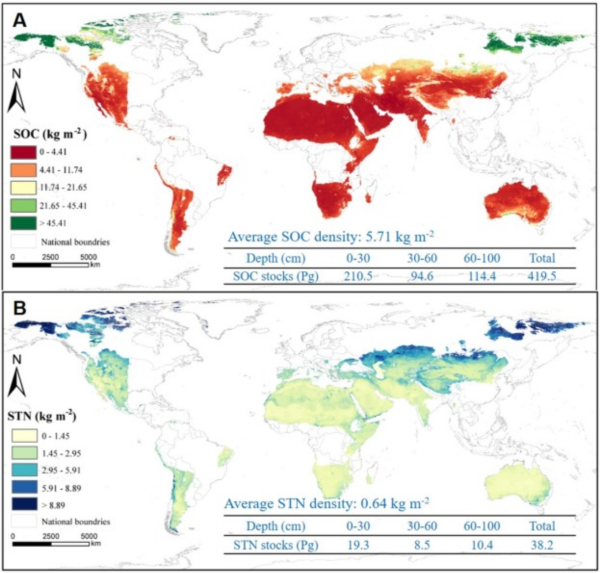Researchers Map Soil Organic Carbon and Soil Total Nitrogen in Global Drylands
2024-11-06
Soils are the largest carbon and nitrogen pools in terrestrial ecosystems, and small changes in them will have a significant impact on atmospheric CO2 and N2O concentrations, which in turn will have a huge impact on global climate change. However, understanding of dryland soil carbon and nitrogen stocks remains limited.
In a study published in Geoderma, a research team led by Prof. ZHANG Yuanming from the Xinjiang Institute of Ecology and Geography (XIEG) of the Chinese Academy of Sciences, explored the spatial distributions of soil organic carbon (SOC) and soil total nitrogen (STN) in global drylands, and predicted changes of SOC and STN stocks under different climate scenarios.
Researchers used data from 12,000 sites in 129 countries across the global drylands to estimate SOC and STN stocks in different land cover types.
They found that global drylands SOC and STN stocks in the top 100 cm soils were 419.5 and 38.2 Pg, respectively, with the upper 0-30cm accounting for half of the total. Forests, shrublands, and grasslands were identified as the largest reservoirs of SOC, whereas forests, bare lands, and croplands were the largest reservoirs of STN.
Researchers used random forest model and structural equation model to explore the drivers and their effects on SOC and STN. They found that for the upper 0-30 cm soils, mean annual temperature, pH, and aridity were the main factors driving spatial patterns of SOC and STN densities; for 60-100 cm soils, soil texture was the key factor.
Besides, the researchers predicted the changes of SOC and STN stocks in global drylands under different climate scenarios. SOC and STN stocks were projected to decrease by 3.6% and 4.0% from 2020 to 2100, respectively, under the Representative Concentration Pathways (RCP) 4.5 scenario. Both SOC and STN stocks would further decrease under RCP 8.5 scenario.
This study provides novel insights for soil carbon and nitrogen stocks in drylands, and can help formulate land management practices and climate mitigation policies.
Article link: https://www.sciencedirect.com/science/article/pii/S0016706124003045

Spatial patterns of soil organic carbon (SOC) density (A, 0–100 cm) and soil total nitrogen (STN) density (B, 0–100 cm) and their stocks of different depths in drylands. (Image by XIEG)
Contact
LONG Huaping
Xinjiang Institute of Ecology and Geography
E-mail: longhp@ms.xjb.ac.cn
Web: http://english.egi.cas.cn



